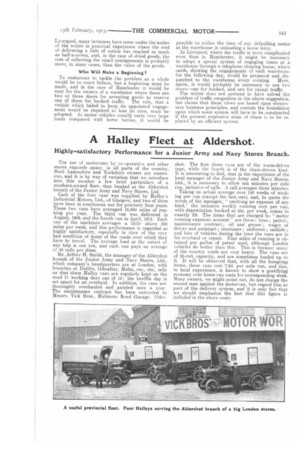A Halley Fleet at Aldershot.
Page 29

If you've noticed an error in this article please click here to report it so we can fix it.
Highly-satisfactory Performance for a Junior Army and Navy Stores Branch.
The use of inotorvans by co-operative and other stores expands apace, in all parts of the country. Such Lancashire and Yorkshire owners are numerous, and it is by way of variation that we introduce into this number a few brief particulars of a southern-owned fleet—that located at the Aldershot branch of the Junior Army and Navy Stores, Ltd.
Each of the four vans was supplied by Halley's Industrial Motors, Ltd., of Glasgow, and two of them have been in continuous use for precisely four years. These two vans have averaged 16,000 miles of running per year. The third van was delivered in August, 1909, and the fourth van in April, 1912. Each one of the machines averages a little above 300 miles per week, and this performance is regarded as highly satisfactory, especially in view of the very bad condition of many of the roads over which they have to travel. The average load at the outset of any trip is one ton, and each van pays an average of 50 calls per diem.
Mr. Arthur H. Smith, the manager of the Aldershot branch of the Junior Army and Navy Stores, Ltd., which company's headquarters are at London, with branches at Dublin, Gibraltar, Malta, etc., etc., tells us that these Halley vans are regularly kept on the road 11 working days out of 12: the twelfth day is set apart for an overhaul. In addition, the vans are thoroughly overhauled and painted once a. year. The maintenance contract has been entrusted to Messrs. Vick Bros., lialimote Road Garage, Alder shot. The first three vans are of the worm-driven type, while the fourth is of the chain-driven kind. It is interesting to find, that in the experience of the local manager of the Junior Army and Navy Stores, Ltd., it is necessary to allow ten minutes per mile run, inclusive of (lulls. A call averages three minutes.
Taking an actual average over 150 weeks of working per van (except the last one), and, to quote the words of the manager, "omitting no expense of any kind," the inclusive weekly running cost per van, with depreciation booked at 35s. per week, comes to exactly 29. The items that are charged to " motor running expenses account" are these: tires ; petrol; maintenance contract ; oil and grease ; wages of driver and assistant; insurance ; uniforms; carbide ; and hire of vehicles during the time the vans are in for overhaul or repair. Nine miles of running is obtained per gallon of petrol used, although London vehicles do better than this. This is because. many of the country roads are very heavy. The vans are of 25-cwt capacity, and are sometimes loaded up to it. It will be observed that, with all the foregoing items, these vans cost 7.2d. per mile run, and this, in local experience, is known to show a gratifying economy over horse-van costs for corresponding work. Many owners, we might point out, do not charge the second man against the motorvan, but regard him as part of the delivery system, and it is only fair that we should emphasize the fact that this figure is included in the above costs.
































